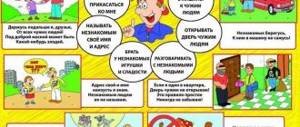Rules of behavior in the forest for children (memo)
If you are planning to go hiking, then it’s time to learn the rules of behavior in the forest for children. While walking, you need to remember about preserving nature and, of course, your own safety. To protect yourself from ticks and other insects, it is advisable to wear a hat or panama hat, a jacket or sweater with long sleeves, thick pants, they should be tucked into your shoes, it is better to put on rubber boots. You also need to use special creams and ointments for insect bites. Be sure to have a supply of water with you, at least for a day. Don't forget about personal hygiene products.
Safe behavior in the forest
You need to remember how to behave in the forest.
To ensure that communication with nature leaves only good memories, let’s consider the basic rules that help avoid dangerous unforeseen situations:
- do not go into the forest alone, only with adults;
- take a phone with you to contact relatives;
- you need to return from the forest before dark;
- do not go deep into the forest;
- You should not enter the forest by vehicle, this will harm the vegetation;
- It is forbidden to light a fire without adults, because fire is dangerous both for humans and for the inhabitants of the forest, it is very difficult to stop its spread;
- Do not burn dried grass or leaves;
- do not throw garbage, you cannot pollute nature, this is a home for animals and birds;
- do not break the glass, you will injure yourself and harm the inhabitants of the forest;
- You cannot make noise in the forest: shout, listen to loud music, such behavior causes anxiety among forest inhabitants;
- do not offend wild animals, they are dangerous in an angry state, if there is a danger of attack, do not show fear and do not stand with your back, it is better to slowly stand and wait for the animal to leave;
- You should not take away baby animals, they can be carriers of very dangerous diseases;
- do not touch the nests of birds, chicks, eggs, because the birds may be in danger, you may attract the attention of predators, also never take the chicks with you, they will not be able to survive in captivity;
- do not destroy anthills, ants are the orderlies of the forest, their work brings great benefits;
- do not catch bumblebees, butterflies, dragonflies, ladybugs, they pollinate plants and destroy pests; by destroying them, you will endanger nature;
- do not catch frogs and tadpoles;
- do not kill spiders, do not tear webs;
- Walk in the forest only along paths, do not trample vegetation and soil, because herbs and many insects may be damaged;
- do not break branches of bushes and trees, do not make memorial inscriptions on them, do not tear off the bark, do not collect sap from birch trees (if you do not have the necessary skills), take care of them, do not harm them;
- do not pluck flowers, especially from the roots, because they will not grow again, among them there may be rare ones listed in the Red Book; forest flowers should delight with their beauty, and not wither in bouquets;
- It is allowed to collect familiar medicinal herbs, berries, and nuts if there are many of them in the forest;
- never taste unfamiliar berries, plants and mushrooms, there is a high probability that they are poisonous;
- You can collect edible mushrooms only under the supervision of adults, never tear them out, use a knife so as not to damage the mycelium;
- Do not trample inedible mushrooms, because they are food for animals. Remember, proper behavior in the forest is the key to your safety.
What to do if you get lost in the forest
So, the basic rules on how to behave in the forest if you get lost. In this situation, you should not give in to panic and run without looking back. You need to calm down, stay in the same place and call for help. You weren’t found, which means it’s time to call your relatives and friends; if there is no connection, then you should dial the emergency number - 112, it is always available. Tell us about your surroundings and they will tell you how to get out of the forest. Rules of behavior in the forest for schoolchildren imply knowledge of parts of the world. At noon, stand with your back to the sun, your shadow will point north, east will be on your right hand, and west will be on your left. Follow the instructions of the emergency services specialist.
If you don’t have a phone, then listen to the sounds around you, hearing human voices, the sound of cars or other signs of civilization, go in that direction. If there are no such sounds, then you should find a stream, it will definitely lead to a river; if there is a river, it means there will be people nearby. Along the route, leave notches on the trees or break branches, this will indicate your direction to the rescuers and will help you if you walk in a circle. Nature changes, so you shouldn't rely on the location of moss and anthills. Try to remember which side you entered the forest from, in which direction you were moving. Look around, if you see power lines, follow them.
If you couldn't get out of the forest and it's getting dark, get ready to spend the night. You need to make a hut from branches, make a small fire (taking precautions), and go to sleep near the fire. Think only about the good, a new day will come, and they will definitely find you.
Rules of behavior in the forest
www.rastut-goda.ru
We organize the trip correctly
Children are curious and spontaneous creatures. No matter how well they learn the rules of behavior in the forest, once they are “in place” they can simply forget, get confused or get carried away by new experiences. Therefore, all responsibility falls on the shoulders of adults. Safety in the forest depends not only on the rules of behavior, but also on the organization of the trip. Adults should approach this with all seriousness, without missing a single important detail:
- Choosing a location. There are no “unexplored paths”; the hiking location must be safe, repeatedly traveled and known to the adults accompanying the children. You should not go deep into the forest, even if you know these places well. Wildlife is unpredictable.
- It's time to go. Choose the first half of the day for a hike in the forest. Don't forget that it gets dark in the forest earlier than in the city. The approaching twilight may make it difficult for you to get your bearings.
- Provisions. When going on a hike in the forest, take care of a snack. No raw meat - making a fire in a forest area is prohibited and dangerous. Let it be bread, salads, canned food, sausages and cheeses. Don't forget about drinking water. There should be enough of it, as well as food.
- Protection from insects. Everyone knows that there are much more bugs and mosquitoes of all kinds in the forest than in the city. Therefore, the backpack should have ointments, insect repellent sprays, and children (as well as you) should have scarves, panama hats and caps on their heads.
- Ratio of adults to children. There should be a lot of adults. Even if one or two teachers can easily cope with an entire class in the theater and museum, when going into the forest, enlist the support of parents and other teachers. Even the most obedient children in nature, when relaxing, behave more actively. Curiosity pushes children to violate even the strictest prohibitions, so they need to be monitored every minute. The younger the children, the more accompanying persons there should be. For a group of preschoolers, the ratio should ideally be “1 adult to 5 children.”
Consultations for parents about child safety on the road and at home
In addition, you should have all the necessary items on hand:
- Knife;
- Matches;
- Compass;
- Fully charged phone and portable battery, if available;
- Flashlight;
- First aid kit.
Reminder of rules of behavior in the forest for children in pictures
Slides and text of this presentation
Children must remember and understand: Birds’ nests must not be destroyed! If you saw an egg in the grass or heard the cries of chicks, do not approach, do not climb there and do not disturb either the birds or the nest.
Ants are forest orderlies; It’s not for nothing that people called them that! So that the forest is beautiful and healthy, Without harmful larvae and beetles, Ants are on guard day and night: They drive various bark beetles away!
Just don’t bother them, my friend! Don't destroy anthills! These orderlies are so needed for the forests of your native country!
For hedgehogs and squirrels, the Forest is their home. They live there boldly, both in summer and winter:
Therefore, you should not take them to the city... Believe me: they are in captivity They will not eat or sleep...
They find food to raise their children and don’t want to leave the forest at all...
Moths fly in the forest, boogers and beetles crawl... Mother Nature gave them life. They all have their own things to do.
You will see them on the way - Don’t offend, but move away! Without insects, the forest, my friend, is lonely and empty...
Flowers decorate meadows and forests. But this is not only the beauty of nature. Bees find a healing gift in them, And butterflies drink sweet nectar from them. There is no need, friends, there is no point in tearing them, There is no need to make bouquets out of them... The bouquets will wither... The flowers will die... And there will no longer be such beauty!
There are rare flowers, White and tender: Lilies of the valley, snowdrops will nod to you warmly...
Just don’t tear them up - with them the forest is kinder, brighter. After all, now there are very few such flowers on earth...
A colored butterfly flutters above you... The dragonfly frolics, dances, has fun...
Everyone is so excited about summer! There is no need to catch them... Let them fly and decorate the Earth...
The forest has its own music... Listen to it, friends! Here are the trills of birds, Here is a squirrel jumping up and down, And here is a grasshopper chattering, A woodpecker is knocking on a branch...
So many sounds here and there! There is no need for noise and hubbub in the forest: You can’t make noise, shout, shout, or play loud music!
It is dangerous to have fun with fire without adults - the fun can end horribly. Sometimes it can be very dry in the forest. A fire will turn into a serious disaster! Imagine that the flame will easily flare up, will begin to blaze, scatter and sparkle - It will be impossible to extinguish it then... Forest fires are a big problem!
You guys have come for a hike... Of course, you need to rest: Play and frolic, And eat and drink... But there are still banks, Cellophane, pieces of iron, bottles around...
You can't leave them here! Let's not be lazy, friends: The garbage here in the forest is alien, Let's take it with us!
You can’t throw glass in the forest, You can’t break bottles; Sharp fragments are dangerous - you will cut yourself terribly on them!
And if you suddenly fall on them, you could end up in the hospital! And the forest inhabitants don’t need Glasses either...
The trees stand like giants. The hooligans don’t spare them And they cut them with sharp knives. The words on the tree are “as a keepsake!”
But it’s such a cruel thing to do! You can't harm trees. Let them grow in the forest - bring goodness and beauty...
If you are going to pick mushrooms, take a sharp knife with you; Carefully cut off the mushroom with them - leave the mycelium in the ground.
And if you come across strawberries, a lingonberry or blueberry bush, gently pick the berries, but leave the bush, take care of it.
There are a lot of different mushrooms in the forest... Don't touch the inedible ones! Don’t put them in a basket, But don’t knock them down either... Forest animals need them: Foxes, hedgehogs, hares...
Only people don’t eat them: There’s poison in toadstools and fly agarics! But for forest animals, that mushroom is still useful and good.
Don’t offend the snake And when you see it, don’t grab the stick, Don’t wave your arms, don’t shout - Just step away and be quiet...
Although snakes are dangerous, they are necessary: They must preserve cleanliness; Don’t do harm or harm to the forest and water orderlies...
With the onset of the summer season, many people begin to go to the forest to pick mushrooms and berries. Very often, during such walks, parents are accompanied by children who, due to a certain lack of awareness, do not understand how to behave correctly in the forest. Improper behavior in a forest can cause an emergency, such as a fire.
In addition, a child can get lost and get lost, so before you go on such a walk with him, you should definitely give an introductory briefing on the topic “rules of behavior in the forest for children in the summer.”
A reminder about the rules of safe behavior in the forest for children
To ensure that a dangerous situation does not arise as a result of visiting a forest area, the child must follow certain rules, namely:
- Children of any age should go to the forest exclusively with adults. Independent walks through the forest area are not permitted under any circumstances.
- While in the forest, you should not go deep into the thicket. It is imperative to keep a trail or other landmarks in sight - a railroad, a gas pipeline, a high-voltage power line, a road for cars, and so on.
- You should always have a compass, a bottle of water, a mobile phone with sufficient battery power, a knife, matches and a minimum set of food items with you.
- Before entering a forest, you should definitely look at the compass to know which side of the world you are entering from. If this device is in the hands of a child, parents should make sure that he knows how to use it.
- If a child falls behind the adults accompanying him and gets lost, he should remain in place and scream as loudly as possible. At the same time, during the walk itself, you should behave as quietly as possible, so that if danger arises, no one doubts what exactly happened.
- While in the forest, you should not throw any burning objects on the ground. In the event of a fire, you should run away from the forest area as quickly as possible, trying to move in the direction from which the wind is blowing.
- Finally, children should not put any unfamiliar berries or mushrooms in their mouths.
All these recommendations must be conveyed to the child from a very early age. Remember that the forest is a place of increased danger, in which it is very easy to get lost, but at the same time very difficult to get out. While in the forest with your son or daughter, try not to take your eyes off him, and if the offspring disappears from your field of vision, immediately call him in a loud voice.
Copying information is permitted only with a direct and indexed link to the source
the best materials from WomanAdvice
Subscribe to receive the best articles on Facebook
kleotur.info
Preparing the children for the hike
Once you have thoroughly prepared yourself, you need to instruct your children on how to behave safely while camping. They begin to prepare children for a forest adventure in advance, telling and explaining what they can do and what they absolutely cannot do. All your “don’ts” should be clear and understandable for children. It’s just that some children perceive the word “you can’t” as “if no one sees, then it’s possible.” Therefore, it is very important not just to ban, but to explain to children everything that can happen to them (and to the forest) if they break the ban. If you are planning to pick mushrooms and berries, you must first introduce children to the names of mushrooms and teach them to distinguish edible mushrooms (berries) from inedible ones.
- For children of middle and high school age, it is enough to have a conversation and distribute a reminder or booklets. Special signs used by foresters and firefighters for the safety of people and wildlife are studied;
- For younger children, the conversation should be repeated and emotionally charged, the booklets more colorful. It wouldn’t hurt to watch a movie and conduct a class hour on the topic “save nature”;
- Preschool children are more emotional, more obedient, but they are also more curious than their older friends. It is much more difficult for them to remember the rules of behavior, which is why preparation for a hike requires a longer period. The memo is replaced by pictures, which the parent or teacher explains in detail. Educational cartoons, fairy tales, and the didactic game “Rules of Conduct in the Forest” are used as means of instructing preschoolers.
Rules of conduct for children during the holidays







